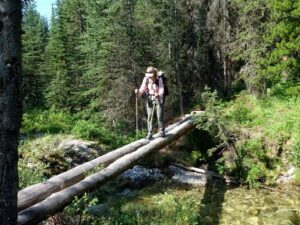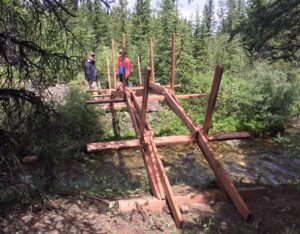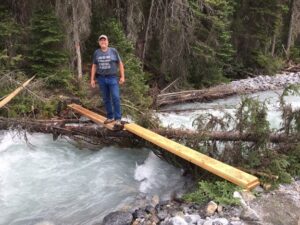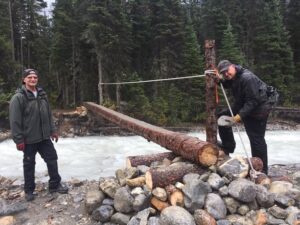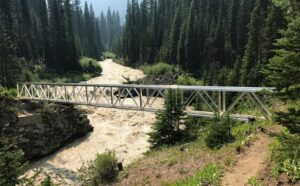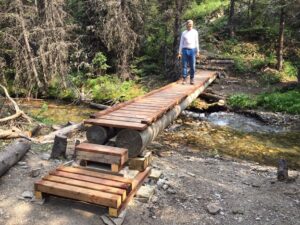by Dave Higgins
When it comes to stream crossings on the Great Divide Trail, that is indeed the question. Let’s see if we can come up with an intelligent answer! But first, some background and history:
The many creeks and rivers traversed by the nearly 1200 km route are barriers to safe, efficient foot travel. While “building bridges” is an obvious solution, it also happens to be a great metaphor full of positive connotations and possibilities (not to mention clichés, but let’s cross that bridge when we get to it!). I really like the notion, for example, of transcending both physical AND metaphorical barriers – philosophical differences between groups of people, for example. You can see this happening on each and every one of our bridge-building work trips. We often talk about building not walls but bridges. Hey, even the parts of songs are connected by bridges!
Famed Spanish architect and bridge designer Santiago Calatrava has this to say on the topic: “Building a bridge, in my opinion, is a symbolic gesture, linked with the needs of people who cross over it, and with the idea of overcoming or surmounting obstacles. A bridge can also be a work of art. It helps to shape our daily lives and becomes a vital experience for all the people who use it.”
Just ask Sara Dhooma, 2021 GDT thru-hiker who does a euphoric happy-dance on every bridge she encounters – you’d be forgiven for thinking these are the highlight of her trek! (check out her excellent GDT vlog on YouTube). To Sara, at least, trail bridges have their own special mystique.
I’m not inclined to disagree.

I’ve participated in the building of many bridges along the GDT over the past few decades and have crossed a great many more on trails in different places around the world. For me, encountering a footbridge while hiking is always a positive experience – even the ones that are overkill or seem entirely out of place still get me to the other side without risking life, limb, or wet feet. Perhaps because on my earliest hiking trips crossing a stream without getting soaked usually involved balancing precariously on slippery rocks or whatever remnants of fallen trees happened to be close by. On the other hand, that usually added to the sense of adventure.
Fallen trees were, in fact, the first “official” bridges on the GDT, and if no naturally occurring specimens were present in the vicinity of the crossing, we might have cut down a suitable dead-standing tree, axed off some limbs, and dragged it across the creek. Needless to say, good balance and willingness to take risks were essential traits of the early GDT hiker. Later we began creating simple two or three-log bridges resting on log sills, all using native trees. Few of these efforts lasted more than ten years, but on the other hand none cost any money!
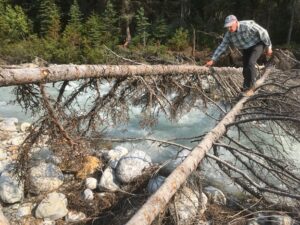
I should acknowledge here that many backcountry hikers view bridges as unnecessary, even intrusive, trail features that detract from the authentic wilderness experience; I can certainly appreciate the sentiment. In my experience, thru-hikers prefer the convenience of bridges but laying down those 40-km days means barely breaking stride as they march straight through creeks and rivers – at least the ones where it’s not overly life-threatening. Aside from the observation that dry footwear is preferable to wet, mountain streams can and do have their bad days, especially following periods of rain or hot weather in the early season. So in my view, some bridges are necessary intrusions. The main questions are: where should they be installed (or not), and what kind of structure is appropriate?
Although I’m very much of the view that a bridge should look as “natural” as possible, practical considerations can get in the way. The more natural a bridge looks, the less safe it is to use and the shorter its lifespan – the fallen tree for example. Forty-plus years of experience as a volunteer organization tells us it’s very hard to keep on top of trail maintenance in remote areas, and many damaged or washed-out bridges take years to fix or replace. The simple bridges we created in the old days seemed perfectly fine at the time – but now we’re a lot more concerned about imposing unnecessary risks on trail users, and suddenly those logs seem awfully narrow and rickety, not to mention slippery in wet conditions – and the lack of anything to hold on to just makes things worse. Thru-hiker accounts confirm that upon encountering such a bridge, many opt to wade across.
Wayne Marshall and Dan Wallace were two of the catalysts for a re-boot of the long-dormant GDTA in the new millennium; one of their first priorities was to build new two-log bridges across several creeks along the original GDT. Their efforts sparked renewed interest in the Trail, and it wasn’t long before the Alberta Government got on board. Alberta Environment and Parks offered to construct new higher-quality footbridges at Cache, Lyall and Hidden Creeks, provided that we augmented their crews with some of our own workers. Later, they paid to have several well-constructed bridges built along the new High Rock Trail, and AEP continues to provide invaluable support to our mission.
Provincial government engagement has been instrumental in improving all of our trail construction standards compared to what they were in the early days. But none so much as the way we build bridges. Safety, longevity and minimizing impact to the local environment and wildlife are now the main drivers of bridge design. Native trees are still used in some cases, but increasingly we’re incorporating “foreign” materials – treated lumber for decking and handrails, cedar poles for stringers being two examples. Over the past six years these materials have been used for several projects along the new High Rock Trail and the “original” GDT in Section B, and at Lambe Creek in Section D. Fortunately for us (and stream health), the newer wood treatment products are completely benign and will not leach out of the wood fibres. These structures, built longer and higher than what they replaced, are expected to last several decades. Not exactly as natural looking as we might prefer, but like most things in life, when it comes to trail bridges there are trade-offs.

Handrails are one such compromise. Many bridges built by the GDTA over the past decade or so don’t have them – if there’s good solid decking on the bridge and no serious risk of injury from a fall, handrails are an unnecessary additional expense (unless they’re needed for structural reasons). A handrail or two will still be included if deemed necessary. At Lambe Creek in Section D, for example, it was just a bit too daunting to shuffle across two slippery logs that span a narrow gorge immediately below a waterfall. A single handrail (plus steel mesh on the logs), added during a 2019 work trip to re-open the David Thompson Heritage Trail, solved the problem.
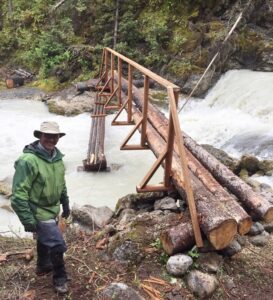
In the “work of art” category, I was the designer and crew leader for a very unusual project in 2020. As part of rerouting a section of the original GDT at Lost Creek in Section B, a new footbridge was needed where none had existed before. Several factors precluded the use of local trees and there was no budget for helicopter support, so it was decided to try building a bridge entirely from treated dimensional lumber, which could be hand-carried piece-by piece to the site. An internet search revealed an ingenious concept invented by Leonardo DaVinci whereby individual lengths of wood (poles in his case) could be assembled without fasteners to create a strong arched structure. I found quite a few modern examples online, and set about building a model to sort out assembly details. Then the real thing was built on my Calgary driveway (to the amusement of my neighbours!). Each piece was lettered for easy re-assembly, then disassembled and loaded into a utility trailer for transport to the Lost Creek parking area, about 1.5 km from the bridge site. With the assistance of local trapper Rod Graham and his ATV, all the materials were moved to the site and Robert Armstrong expertly oversaw the assembly process. This was the only bridge project where previous experience with IKEA furniture was an asset!
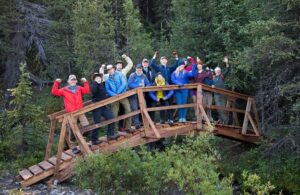
The largest footbridge project ever contemplated by the GDTA – a new, permanent 17m-long structure intended for Cairnes Creek in BC (roughly the midway point of the GDT, in Section D), was engineered with laminated Douglas-fir beams, treated lumber decking and handrails, and galvanized steel gabion cages filled with many tons of rocks for one of the abutments. Designed to survive the creek’s frequent floods and last several decades, the $34,000 project was to be completed in 2021 but refusal on the part of the BC government to give their final approval has delayed it, perhaps indefinitely. Cairnes is one of the most hazardous stream crossings on the GDT, so leaving it as a ford isn’t an option. To make sure hikers had a way to cross the creek during the 2021 season, we fastened some lengths of lumber to a conveniently fallen tree some distance upstream on the floodplain, and removed them at the end of the season.
It took two work trips in July and September, but at last we successfully installed a provisional single-log crossing over this troublesome creek. Armed with various winches, cables and tripods and a lot of ingenuity (thank you Rob Biggs and Robert Armstrong!) we managed to pull a large, heavy spruce log across the rushing creek without getting it wet. The log was raised to a safe height above the creek on log cribbing, and a thick rope handrail was added. That should do the trick for the next few years, or at least until the next massive flood. Fingers crossed!
Near that location we’re planning to install a new 22m-long, permanent bridge over the turbulent Blaeberry River that will enable the official GDT route to follow an historic trail from Amiskwi Pass to Cairnes Creek (currently known as the “Collie Creek Alternate”), bypassing 15 km of tedious logging road travel. An existing road bridge currently used by logging trucks and hikers is due to be removed soon, and without a way to safely get across the river the new route will be unusable. The proposed footbridge will need to be placed by helicopter, dictating lightweight materials to minimize weight.
We got some experience working with a helicopter in July 2021, on the Cataract Creek bridge project in Section B. Like most GDT stream crossings, Cataract is a long way from driveable roads. It’s not accessible by ATV either, so all materials, tools and camp gear had to be airlifted. While costly, the end product is a very robust structure that should survive floods and last decades. In 2022 a similar bridge is being planned to replace a broken two-log crossing at the Oldman River.

Employing helicopters on bridge projects has really moved the needle on construction costs, which started out at virtually nothing when local trees were the go-to solution, to nearly $10,000 for the new Cataract bridge. This figure, however, is still a fraction of what similar projects would cost if undertaken by the government – a volunteer workforce can make a huge difference! Even so, the proposed Blaeberry bridge will still come in at around $50,000 (although 80% of the cost will likely be covered by a grant from the Columbia Basin Trust).
Obviously, we won’t be bridging every creek and river along the GDT with costs like these! So a practical way forward is to identify which crossings are not only dangerous enough to need fixed structures to get hikers safely to the other side, but also whether the effort and expense is risky in and of itself – that is, would the structure survive periodic natural events like floods or forest fires? Many creeks and rivers in Sections F and G, for example, simply don’t have banks high enough to keep the bridge structure above flood level, and often there aren’t enough loose rocks close by to build gabion abutments. On the other hand, most of those streams are easily forded during hiking season. A good thing, because these are the most remote and therefore costly places to build good quality bridges.
Fortunately, the various National and Provincial Parks traversed by much of the GDT route have their own budgets and crews to look after bridge construction and maintenance. That is, when and where they decide a bridge is a necessity rather than a nice-to-have. In the case of some National Parks, there’s a growing tendency to downgrade certain trails to either save money or discourage human use of the backcountry. One example is the Howse River in Section D, which is being left to revert to a natural state forcing hikers to use the floodplain – which wouldn’t be such a terrible thing if the river, which must be forded multiple times, didn’t tend to rise so much during hot or rainy weather.
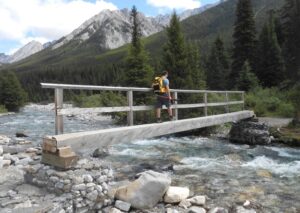
The GDTA will continue to advocate for keeping important park trails like Howse River open and safe to use. But I suppose it’s a good thing most thru-hikers are the sort who feel the additional hardship and danger is an integral part of their GDT trek.
If you asked me to name my favourite type of crossing structure, I’d have to say a suspension bridge. There’s something airy and graceful about these bridges, and they seem to enhance their setting rather than detract in any way from it. Santiago Calatrava again: “Bridges with cables very easily resemble stringed instruments.” He likely had in mind one of his futuristic designs, but I think any suspension bridge, even those flimsy ancient ones spanning some ridiculously deep gorge in the Himalayas, can be described that way. Not only that, but crossing a swaying suspension bridge always adds to the adventure!
So why aren’t we building any of these? The simple answer is cost. For a volunteer organization like the GDTA, spending what it would take to properly engineer and construct a suspension bridge in a remote location, when there are less costly options, means we wouldn’t have funding for other initiatives. Some difficult stream crossings can only be spanned by a suspension bridge, but none of those are along the current GDT route outside of the parks.
Here’s one more good reason for building bridges on the GDT: volunteers like working on these projects. Sure, walking a section of trail that you’ve just completed is always gratifying, but there’s something extra special about standing back to appreciate a beautiful big structure that you’ve helped create with your own hands (additional gratitude, if needed, is always provided enthusiastically by passing hikers). And there are other intangible benefits to working closely with others to solve the many physical challenges. West Indian psychiatrist and political philosopher Frantz Fanon stated: “If the building of a bridge does not enrich the awareness of those who work on it, then that bridge ought not to be built.” A metaphorical assertion, possibly, but I think it would resonate with everyone who’s worked on our GDT bridges. If you haven’t had the chance to experience this yet, all you need to do is sign up for our next bridge-building trip.
I hope I’ve helped to enrich YOUR awareness of our GDT bridge strategy by writing this lengthy piece. Yes, it could have been shorter, but then – strained cliché alert! – it might have been abridged too far!
And if the “intelligent answer” to my opening question isn’t obvious by now, I think we can confidently say it’s Yes …. and No.


